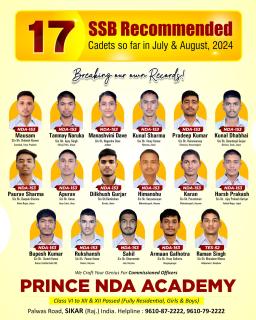The
Common University Entrance Test (CUET) has become a pivotal step for students
aspiring to enter prestigious universities across India. As the competition for
these seats grows fiercer every year, students are increasingly turning to
coaching institutes in Delhi to improve their chances of success. CUET Coaching in Delhi has seen a remarkable
transformation over the past few years, thanks to the integration of modern
technology. The role of technology in enhancing CUET coaching cannot be
overstated, as it has revolutionized how students prepare, learn, and
ultimately succeed in their examinations.
1. The Evolution of CUET Coaching in Delhi
Traditionally,
CUET coaching in Delhi was centered around physical classes held at coaching
centers. While this model provided valuable face-to-face interaction between
students and instructors, it had its limitations. Students had to travel long
distances to attend coaching sessions, and the availability of personalized
attention was limited. Moreover, the vast syllabus for CUET meant that students
had to spend a significant amount of time on rote learning, often at the
expense of understanding the underlying concepts.
With the
advent of digital tools and platforms, CUET coaching has undergone a sea
change. Technological advancements have enabled coaching centers in Delhi to
offer a more flexible, efficient, and personalized learning experience. Today,
students can access study materials, practice tests, and even live classes from
the comfort of their homes, breaking down geographical barriers and opening up
new avenues for learning.
2. Online Learning Platforms and Virtual Classes
One of
the most significant technological changes in CUET coaching is the rise of
online learning platforms. These platforms offer a wide range of resources such
as pre-recorded video lectures, live classes, practice tests, and interactive
quizzes. For students enrolled in CUET Coaching in Delhi, these platforms allow
them to learn at their own pace and convenience.
The shift
to online learning has made CUET coaching more accessible to students from
different parts of Delhi, including those living in remote areas. It has also
helped coaching institutes cater to a larger number of students, offering them
a more cost-effective way to access quality education.
Live
classes, in particular, have become an essential tool in CUET coaching. They
allow students to interact directly with instructors, ask questions, and
participate in discussions. With the help of tools like Zoom, Microsoft Teams,
and Google Meet, instructors can conduct classes in real time, ensuring that
students get personalized attention even in large groups.
Moreover,
the flexibility of online learning allows students to revisit recorded
sessions, making it easier to revise difficult concepts and clarify doubts at
any time. This is especially beneficial for students who may find it
challenging to keep up with the fast-paced nature of CUET preparation.
3. Artificial Intelligence and Adaptive Learning
Another
way technology is enhancing CUET coaching in Delhi is through the use of
Artificial Intelligence (AI) and adaptive learning technologies. These tools
help tailor the learning experience to each student's individual needs, making
CUET coaching more personalized and effective.
AI-powered
learning platforms use algorithms to analyze a student's performance and adapt
the course material accordingly. For example, if a student struggles with a
particular topic, the platform can provide additional resources, practice
questions, and explanations to help the student improve. Conversely, if a
student excels in a certain area, the platform can offer advanced material to
challenge them further.
This
personalized approach ensures that students receive targeted support,
maximizing their chances of success in the CUET exam. Moreover, AI can also
help track a student's progress over time, providing detailed feedback and
insights that guide both students and instructors in making necessary adjustments
to their learning strategies.
4. Digital Study Materials and E-books
The role
of technology in CUET coaching is not limited to online classes. Another
critical advancement is the availability of digital study materials, which have
replaced traditional textbooks. These digital resources, including e-books,
PDFs, and interactive modules, are easier to update and distribute, ensuring
that students always have access to the latest information.
For CUET
Coaching in Delhi, digital study materials have become an essential component
of the curriculum. Coaching institutes can upload notes, summaries, and
additional reading materials to their online portals, allowing students to
access them whenever they need. These materials are often accompanied by interactive
elements such as quizzes, videos, and infographics, which help enhance student
engagement and retention.
Additionally,
e-books and digital resources are much more affordable than traditional
textbooks, making them a cost-effective option for students. The ability to
access these materials on smartphones, tablets, or laptops ensures that
students can study on the go, further improving their convenience and
flexibility.
5. Online Mock Tests and Performance Analytics
Mock
tests have long been an integral part of CUET coaching, as they allow students
to familiarize themselves with the exam pattern, manage their time effectively,
and assess their performance. With technology, the process of conducting mock
tests has become more advanced, offering real-time feedback and detailed
analytics.
Online
mock tests for CUET are now widely available, and many coaching institutes in
Delhi have developed their own platforms for this purpose. These tests simulate
the actual exam environment, providing students with a realistic experience.
After completing a mock test, students receive instant results, along with a
breakdown of their performance in each section.
The data
collected from these tests can be used to identify areas of weakness, allowing
students to focus their efforts on improving specific skills. Coaching
institutes also use this data to monitor overall class performance and adjust
their teaching methods accordingly.
Moreover,
some platforms use AI to analyze a student's response patterns and offer
suggestions for improvement. For example, if a student consistently struggles
with a particular type of question, the system can recommend additional
practice problems in that area.
6. Gamification and Interactive Learning Tools
Gamification
is another innovative way technology is enhancing CUET coaching. By
incorporating game-like elements such as rewards, leaderboards, and challenges,
coaching institutes can make the learning process more engaging and enjoyable
for students. This not only helps maintain student interest but also motivates
them to continue their studies.
Interactive
learning tools such as quizzes, flashcards, and puzzles can be incorporated
into online platforms to make learning more dynamic. These tools allow students
to test their knowledge in a fun and engaging way while reinforcing key
concepts. The interactive nature of these tools ensures that students remain
actively involved in their learning, leading to better retention and
understanding of the material.
Additionally,
gamification fosters a sense of healthy competition among students, encouraging
them to strive for better results and push themselves to excel in their CUET
preparation.
7. Digital Communication and Mentorship
Effective
communication between students and instructors is crucial for successful CUET
preparation. Technology has made it easier for students to reach out to their
coaches and mentors whenever they have doubts or need guidance. Many coaching
institutes in Delhi have adopted communication tools such as WhatsApp groups,
discussion forums, and email support to ensure that students can get prompt
responses to their queries.
Furthermore,
mentorship plays a crucial role in CUET coaching. Students often seek
personalized guidance from their mentors, who provide valuable insights into
the exam pattern, study strategies, and time management techniques. Technology
has made it easier for mentors to connect with students virtually, enabling
them to offer mentorship even after regular class hours.
Online
discussion forums and peer groups also provide students with a platform to
interact with fellow aspirants, share resources, and discuss important topics.
This fosters a sense of community and collaboration, enhancing the overall
learning experience.
8. Virtual Reality (VR) and Augmented Reality (AR)
While
still in its nascent stages, Virtual Reality (VR) and Augmented Reality (AR)
have started making their way into the realm of CUET coaching. These
technologies have the potential to revolutionize how students prepare for exams
by offering immersive, interactive learning experiences.
For
example, VR can be used to simulate real-life scenarios or complex
problem-solving exercises, allowing students to explore concepts in a more
hands-on and engaging way. Similarly, AR can enhance digital study materials by
overlaying additional information or visualizations onto physical objects,
helping students better understand abstract concepts.
Although
VR and AR are not yet mainstream in CUET coaching, their integration into
educational platforms is expected to grow, providing students with even more
innovative ways to learn and prepare for their exams.
9. Conclusion
In
conclusion, technology has played a transformative role in enhancing CUET
coaching in Delhi. From online learning platforms and AI-driven adaptive
learning to digital study materials and virtual classrooms, technological
advancements have made CUET preparation more accessible, efficient, and
personalized. As technology continues to evolve, it is likely that CUET
coaching in Delhi will become even more advanced, providing students with even
more powerful tools to excel in their exams.
For
students aspiring to crack the CUET and gain admission to top universities,
embracing technology in their preparation is no longer an option—it is a
necessity. The integration of technology into CUET coaching has not only
leveled the playing field but has also set new standards for excellence in
education.













